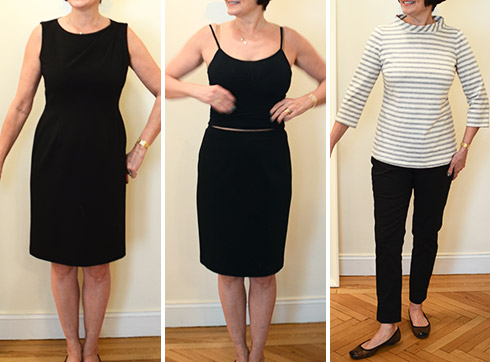When Catherine and I founded Dobbin, we focused on fit as much as we did on fabric and style. We both felt that although there were a plethora of style options on the low end, the fit of the clothes was never quite right. At the same time, we couldn’t afford the very high-end pieces from luxury lines known for fine tailoring. We focused on a fit concept that balanced clean-lined sophistication with comfort. Tired of too small armholes, narrow shoulder seams, too tight and too low waistlines and too short hemlines, we wanted to create pieces that fit and flattered our customers, but that they could truly take from morning to night with ease.
Originally we set out to design for sizes 4-14, ended up adding in size 2 and 16 last minute in production, and eventually added size 0 due to popular demand. Our first fit model (we’ll call her M1) had a body type that fit with the shapes we were looking to dress. She was truly a size 8 on top, with larger-than-standard shoulder measurements, though she was closer to a size 6 on the bottom. To give this some perspective, designers like Marc Jacobs, DKNY, Theory and Alexander Wang use size 2 to size 4, or very small size 6 fit models.
Fit models are hired based on standard measurements. M1 worked for both Missy and Contemporary labels, which we really liked, because we wanted to reach a wide array of customers. Traditionally, high-end lines and contemporary lines use smaller fit models than Missy lines, but the business of fit models is still fairly subjective. Each designer uses the fit model that best suits his or her aesthetic and target customer. Some small designers choose not to employ fit models because of their high hourly pay ($200 or more/hour) and fit on themselves instead. We felt this was a mistake for Dobbin because we really wanted to get the fit right. We didn’t want to cut corners.
M1 fit for us for our first and second seasons, and provided much needed feedback on the fit and feel of our samples at each of our fit sessions. Fit models are very knowledgeable about the intricacies of fit measurements (almost every inch of a garment can be specified) and thoroughly discuss corrections to the pattern with the pattern maker throughout the sampling process.
As I mentioned in my post about working with a pattern maker, we schedule fit sessions throughout the sampling process. During the sessions we fit our samples on the fit model so that our pattern maker can make corrections. We pay close attention to the look of the garment, and to how it moves on the body. Can the model easily swing her arms? Can a jacket fit over her bust with some room to spare (but not look messy)? Is there room for a belly to relax but still to be flattered and look as slim as possible? Is the seat of the pants too tight? Too loose? Can we find a happy medium? These questions motivate us to keep improving our fit. We want to find this balance in every garment we design.
For our third season, we’ve had to hire a new fit model for scheduling purposes. Changing fit models is always a risky move, but we couldn’t risk slowing down our tight production schedule. We found our second fit model, M2, through a series of go-sees during which we took measurements of potential fit models and decided whether they had the right shape for us.
By now, we’re also able to test potential fit models against the existing line — putting size 8’s on each model to see who they fit the best. M2 was the clear choice after trying on our pants and best-selling Juliet dress. Here are some of her key measurements:
- Bust: 36-36.5″ (measurements depend on whether they’re taken with clothes on or off the body)
- Waist: 28.75-29.25″
- High Hip: 36-36.5″
- Inseam to Ankle Bone: 30″
- Muscle: 11 ¾”
There are many other measurements that helped us to decide that M2 was right for us, but they get fairly technical. Again, we chose a model closer to an 8 because we wanted to fit on someone with some curvature to her body. M2 fits primarily for Missy lines but is actually more proportionally balanced than M1 and has been great to work with.
As soon as we’ve gone through 2 or 3 iterations of a pattern and corresponding sample, Catherine and I approve the pattern and turn it over to a marker and grader. Marking and grading is the process of digitally scanning our pattern maker’s hand-drawn and cut pattern and then grading it up and down to the sizes we need. For us, grading is usually even; we use the original pattern size as a base and size it up or down by a half or full inch for smaller sizes and up to 2 inches for larger sizes. It’s key to remember that our size 8 is based on traditional measurements used by the pattern maker and then additionally, on what the pattern ends up measuring at pre-production. This is why our size 8 might differ from another brand’s size 8. Each business has a different size standard.
A few shots of M2 at our most recent fit session.










